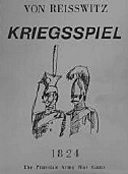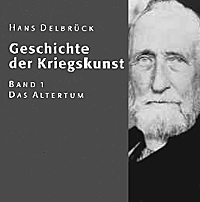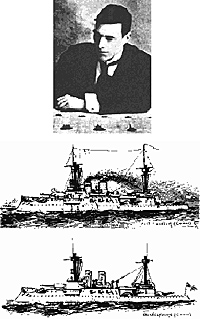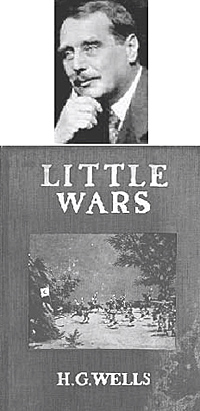1811–24: The Birth of Modern Wargaming
Modern wargames were ushered in by a Prussian named Baron von Reisswitz, the Prussian war counselor at Breslau. In 1811, he invented an innovative war game. First, he constructed a table model of actual terrain. He then used blocks to represent units. Each player would give orders to an umpire, who was required to update the terrain table, resolve combat, and tell the players only what they would know at that point in an actual situation.
To determine casualties, umpires first consulted complex tables that indicated likely attrition based on range, terrain, and other factors. The exact attrition was determined by a roll of the dice, which depicted the uncertainties of the battlefield!
Arguably, not since Johannes Gutenberg’s invention of the movable-type printing press had one man made so many interlocking breakthroughs at the same time. Yet, many historians do not credit Reisswitz with initiating modern war gaming. Why not? Because for all its innovation, Prussia used Reisswitz’s invention in the same old way — educating princes in war. But times were changing.
 To counter Napoléon’s advantage in numbers, the crowned heads of Europe turned to nationalism. Even after defeating Napoléon, dynastic rivalries encouraged — and the industrial revolution permitted — armies to continue to grow. Prussia soon found it had too many soldiers for only the sons of officers to command. Faced with this officer shortage, even conservative Prussia began allowing the sons of mere bankers, industrialists, and government officials to become officers. One of these new officers was Reisswitz’s son, Lieutenant George HRJ von Reisswitz, who soon realized that he and his fellow outsiders simply did not know as much about war as those who had been taught it at their father’s knee. He believed his father’s game could help.
To counter Napoléon’s advantage in numbers, the crowned heads of Europe turned to nationalism. Even after defeating Napoléon, dynastic rivalries encouraged — and the industrial revolution permitted — armies to continue to grow. Prussia soon found it had too many soldiers for only the sons of officers to command. Faced with this officer shortage, even conservative Prussia began allowing the sons of mere bankers, industrialists, and government officials to become officers. One of these new officers was Reisswitz’s son, Lieutenant George HRJ von Reisswitz, who soon realized that he and his fellow outsiders simply did not know as much about war as those who had been taught it at their father’s knee. He believed his father’s game could help.
In 1824 he adapted his father’s game so it could be played on topographical maps. At a stroke, he made wargaming cheaper, more convenient (unlike a sand table, a map could be rolled up), and more flexible. The younger Reisswitz soon demonstrated his innovation to the Prussian chief of staff, General Karl von Muffling. After initially being bored and skeptical, Muffling became increasingly excited.
Finally, he exclaimed, “It’s not a game at all, it’s training for war. I shall recommend it enthusiastically to the whole army.”
Actually, he soon ordered all garrisons to conduct wargames. This was the beginning of the young lieutenant’s problems. His fellow officers resented the time these cumbersome wargames required. Finding his isolation intolerable, he took his own life in 1827.
 1825–71: Wargaming Comes of Age
1825–71: Wargaming Comes of Age
Of course, not all officers hated war gaming.
Von Muffling (left) and Von Moltke (right)
As early as 1828, Lieutenant Helmuth von Moltke advocated the use of war games. He even founded the Magdeburg (Wargaming) Club. In 1837, now as General von Moltke, he became chief of staff of the Prussian army and ordered an increased use of wargaming. Although he met initial resistance, Moltke understood what motivated his subordinates and he soon devised a strategy to increase the use of wargaming.
While Prussia had used nationalism to overcome France’s advantage in recruiting, it found that adopting a meritocracy was more difficult. Prussia’s solution was to pair commanders selected for their nobility with chiefs of staff selected by merit. Because the only chance even members of the petty nobility had of attaining high rank was selection for the staff corps, virtually all officers wanted to be selected. However, only graduates of the War College were eligible. Moltke now required that each application package include a letter from the applicant’s commander, evaluating his performance as the senior umpire for a wargame. It worked.
When the successful applicants became War College students, Moltke saw to it that they did a great deal more wargaming. Wargaming appears to have always been part of the curriculum at the War College, but Moltke added several innovations collectively called the staff ride. Periodically, Moltke would take the entire student body of the War College to one of the actual invasion corridors into Prussia. Moltke would then describe the most likely first clash between invading and Prussian forces. He would then turn to the most junior student present and ask for his plan of battle. Next he would ask the second most junior, then the third, and so on. Why? If the most senior spoke first, would any disagree?
After arriving at a consensus battle plan, they then played a map-based wargame. Moltke would then name the senior ranking general (aside from himself) to command the invading forces and the second-ranking general to command the Prussian forces. He continued thusly until they were split into two equal teams. Why? Moltke believed that if their plan could succeed against some of their smartest strategists, it would probably also succeed against any enemy strategist. Also, with two equal-sized teams, more officers could participate meaningfully.
The next day, he would contact the local garrison (remember the staff ride was being conducted in an actual invasion corridor, so there would always be a garrison). He would direct the garrison commander to march a few hundred soldiers where the plan called for thousands to march. This was done to test the marching times and other details of the plan. When all this was done, the plan went on the shelf as the actual plan for an invasion along that corridor.
Now let us think about all this for a minute. Moltke started with an “off site” (to an environment conducive to candor and free thinking), had a team brainstorm to reach a consensus, tested the resulting plan against a world-class adversary, and finally tested the results with a field exercise. Essentially, he used many smart people and effective procedures to create a plan worthy of a genius, eliminating Napoléon’s final advantage of genius. With all our technology, are we really this conceptually sophisticated today?
1872–1913: Wargaming Becomes Global
Oddly enough, Moltke and Prussia won a series of wars, usually against opponents with larger forces that were technologically equivalent. Not surprisingly, the rest of the world started copying Prussia’s (now Germany’s) wargaming methods. While there were local variations, the pattern was strikingly similar. A young officer would translate German manuals, often improving some aspect in the process. He would meet initial opposition, but in time the use of wargames became institutionalized.
1776–1912: Coming to America
Like so much about America, our wargaming is partially home grown and partially acquired from other nations. Most observers credit Major WR Livermore of the Corps of Engineers with bringing modern wargaming to America.
In 1883, Livermore freely admitted he started by simply translating German rules. However, he then went on to compare their attrition tables to actual statistics from the American Civil War and Prussia’s own wars in 1866 and 1870–71. He found that the German attrition tables usually predicted lower casualties than the historical record indicated, and he adjusted his tables accordingly.
Despite this historical foundation, when Major Livermore sought official acceptance of wargaming, he was blocked by General William T. Sherman, the US Army’s chief of staff at that time. He disapproved Major Livermore’s proposals, stating that wargames depict men as if they were blocks of wood rather than human beings who are seized by fear and sustained by leadership. His basic objection was that Major Livermore’s wargame, like all up to that time, only depicted attrition as units fighting to the last man. Sherman knew better.
While one living legend blocked wargaming in the Army, another was advancing it in the Navy. William McCarty Little was one of those historical anomalies who shaped the world far more than rank or title would suggest. He had been medically retired for dubious cause in the middle of a promising naval career. Instead of being bitter, he went on to help found the Naval War College and to father naval wargaming in America. For years he did so as a volunteer, receiving no pay beyond his retirement stipend. In 1887, he wrote and delivered the first lecture on wargaming given to an audience of professionals in the United States.
While he drew on his conversations with Major Livermore and the writings of Captain Sir John Phillips Colomb of the Royal Navy, many of the insights were his own. Also in 1887, he and Major Livermore conducted the first joint Army-Navy wargaming field exercise. The Army high command promptly forbade any future joint exercises. In 1889, McCarty Little ran a wargame at the Naval War College, and wargames have been conducted there every year since then.
McCarty Little’s selfless labors gradually paid off. As early as 1894 and 1896, wargames influenced the Navy’s budget. In 1895, a wargame played a decisive role in convincing Congress to fund the Cape Cod Canal. In 1899, the Army established a war college, and McCarty Little did what he could to ensure that its curriculum included wargaming. It has done so from 1899 to the present day. Soon the Army began innovation, turning to transparent overlays instead of blocks so that a permanent record of each move could be made. Also, to standardize the input of moves to the umpire, they devised a format for an operations order. It was the father of the joint format still used today and of map overlays.
While success was gradual, we can use a remarkable 1912 article in the US Naval Institute Proceedings to declare victory. In this visionary article, McCarty Little describes concepts that are considered new today. He argued that wargaming had shaped and should continue to shape national policy; that it was the cure for peacetime “stove-pipe” mentality; and that it could not only produce better plans but could condition its practitioners to think and react quicker then their enemy, and hence gain an important advantage. The clarity, persuasiveness, and confidence of this remarkable article clearly indicated wargaming had come to America—and like earlier immigrants had truly become American.
1872–1905: German Wargaming, Innovation, and Decline
While wargaming was spreading throughout the world, it was not standing still in Germany. Unfortunately for that country, not all of wargaming’s movement was in a forward direction.
The combat experience that Prussia/ Germany gained during their wars of unification had a powerful influence on their wargaming. Sherman could have told them one of the first things they had to learn: units do not fight to the last man. In 1877, a Saxon captain named Naumann published rules to cover what today we would call “break points”; that is, the rules provided criteria for determining at what casualty level units would cease functioning.
The second innovation came to be called Free Kriegsspiel. A series of books published between 1873 and 1876 argued persuasively for a radically different type of wargame. The concept was simple.
Wargames have always been unpopular due to the cumbersome, time-consuming rules of adjudication. Therefore, combat-experienced officers were allowed to substitute their military judgment for many of these rules. This would result in games that were faster and thus more popular, hence played more often.
At first, Free Kriegsspiel seemed to work well. At its best, the professional judgment of experienced combat veterans could produce more accurate outcomes in less time. There were two problems, however.
First, Germany’s veterans of 1871 gradually aged, retired, and died. Their replacements could not adjudicate with the same authority.
The second problem is today called command influence. When one of the players outranked the umpire, that player tended to value his professional judgment over that of the umpire. Nowhere was this problem more visible or more damaging than in the case of Kaiser Wilhelm II. Thinking himself a great military genius, Kaiser Wilhelm never missed a staff ride. The rides still started on a hill overlooking a possible invasion corridor. Just then Moltke would have asked the most junior officer for his opinion, the Kaiser would immediately announce the “perfect” battle plan. You can imagine the level of debate.
Then, during the actual wargame, instead of having the teams split evenly, everyone wanted to be on the Kaiser’s team. The results were predictable; the Kaiser’s side always won. It was Germany’s loss.
 1890s–1913: The Birth of Second-Generation Civilian Wargames
1890s–1913: The Birth of Second-Generation Civilian Wargames
While many of the citizens of the Western democracies had played chess since the time of Franklin and Voltaire, they had missed out on the second generation of simulation wargames initiated by Reisswitz. Perhaps not surprisingly, the “technology transfer” that led to the civilianization of wargaming started with a couple of reservists—one British, one German.
Spenser Wilkinson began his crusade while still attending college. In 1873, while on summer vacation in Germany, he was glancing through a pamphlet about the military balance and was shocked to learn that Britain’s army was among Europe’s smallest. Among his many initiatives, Wilkinson organized England’s first wargaming club. Presumably through Wilkinson’s efforts, one member of Parliament in 1900 listed wargaming as a hobby.
The German reservist’s contribution to civilian wargaming was more indirect. Civilians had to be motivated to study war before they could become interested in complex simulation wargames. Hans Delbrück provided that motivation. His family had advised Prussian kings on matters of war for generations. He wrote that “it was vital that the king understood war for it is on the outcomes of war that the nation prospers or dies.
 Now Germany is evolving toward a democracy, the people are becoming the sovereign, and it is just as important that they understand war.” To help the people study war, he became the foremost military historian of his time. A prolific and influential author, he founded the first chair of military history at a civilian university and edited the first defense affairs journal aimed at a civilian audience.
Now Germany is evolving toward a democracy, the people are becoming the sovereign, and it is just as important that they understand war.” To help the people study war, he became the foremost military historian of his time. A prolific and influential author, he founded the first chair of military history at a civilian university and edited the first defense affairs journal aimed at a civilian audience.
Interestingly, both the first modern naval and land wargames intended for a civilian audience were published in England.
Fred Jane
The first publication detailed rules for naval battles that required very detailed ship profiles. Data on only four ships were included with the game, and customers were soon clamoring for more. A game supplement with the needed profiles for all British ships soon followed. Still, playing a wargame between British ships was a little like kissing one’s sister. His next offering provided the needed data for the entire German navy. There was an uproar in the press—“The Germans are our friends”; “How dare he imply our navies may someday fight!”
To avoid singling out any one nation, Fred Jane next published Jane’s All the World’s Fighting Ships. So the entire Jane group that has contributed so much to the reference sections of libraries and to the British balance of payments started with a wargame.
H.G. Wells
 Finally, a ground combat simulation war game was published for civilian use. The author’s avowed purpose in designing the wargame was to help civilians better understand how terrible war was.
Finally, a ground combat simulation war game was published for civilian use. The author’s avowed purpose in designing the wargame was to help civilians better understand how terrible war was.
He predicted that if the people of democracies truly understood how terrible war was they would make sure their governments would never again start one.
While the author, HG Wells, made many correct predictions in his long career, this one was, at best, premature. His book of rules, called Little Wars, was published in 1913.
While both works were fairly popular, the number of civilians playing simulation wargames would remain modest for many decades. The fairly complex rules deterred some, but the main problem was the cost of the metal soldiers or ships. Only the well-to-do could afford full sets of such miniatures around the turn of the last century. Still, this is not to say early civilian simulation war-games did not have an impact. One young British aristocrat enjoyed wargaming with miniatures well into his adult years—his name, Winston Churchill.
Toward a History-Based Doctrine for Wargaming
- Introduction
1811-1904: Wargaming Beginnings
1905–18: Wargaming and the Great War
1919–38: Interwar Wargaming: The Visionary and the Blind
1939-1945: World War II
1946-1980s: Decline and Revitalization
1990s: Gulf War and More
Back to Simulacrum Vol. 4 No. 3 Table of Contents
Back to Simulacrum List of Issues
Back to MagWeb Master Magazine List
© Copyright 2002 by Steambubble Graphics
This article appears in MagWeb (Magazine Web) on the Internet World Wide Web. Other articles from military history articles and related magazines are available at http://www.magweb.com